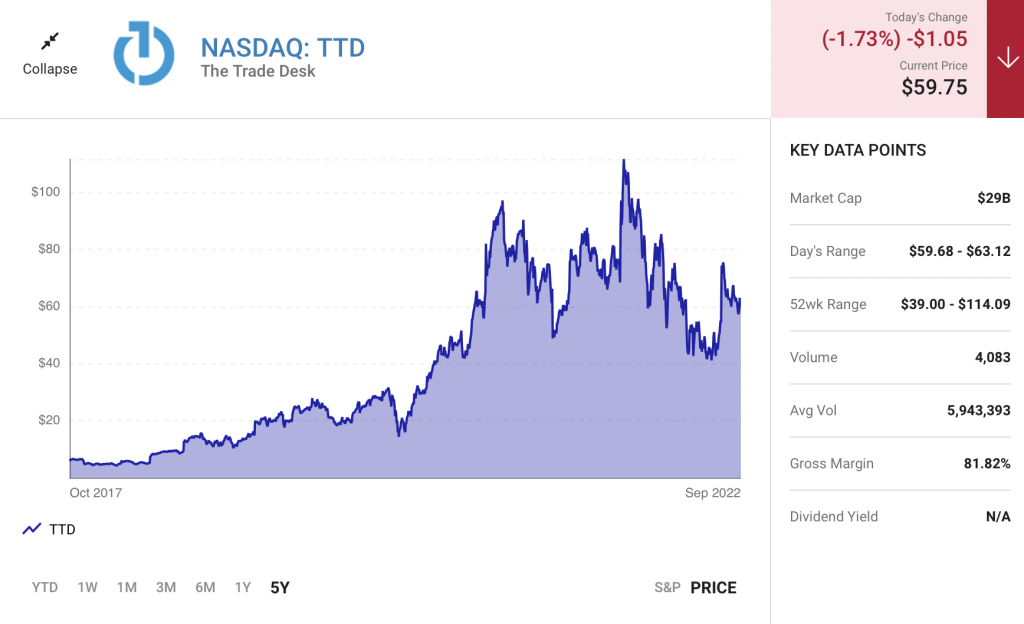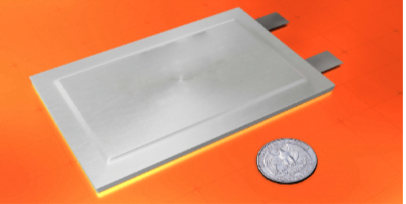This fast-growing ad-tech company has been mauled by the bear market, but this too shall pass.
Technology stocks have been beaten down this year as investors abandoned high-growth companies with similarly high valuations. This problem was compounded further by 40-year-high inflation, rising interest rates, and an arguably worsening recession. These factors have pushed the Nasdaq Composite into bear market territory, with the widely followed index down roughly 33% from its November high.
As bad as things might seem at the moment, the good news is that the bear market will eventually give way to the next bull run. Until then, investors should be on the lookout for the sterling opportunities that such sell-offs create. Perhaps one of the best examples of that is The Trade Desk (TTD -1.73%). The company, which uses high-speed computers and sophisticated algorithms to automate the digital ad-buying process, has seen its stock crater by nearly 46% as of this writing, despite the company’s compelling growth story.
Can The Trade Desk navigate the macroeconomic headwinds that have dragged its stock down this year? Let’s dig into the company for insight.

The Trade Desk’s numbers tell the tale
One of the most widely recognized phenomena during an economic downturn is indiscriminate selling as fair-weather investors flee for safer shores. Like many technology issues, The Trade Desk had been beaten down since all-time highs reached late last year, yet that belies the underlying strength of the company’s financial results. Last year, The Trade Desk generated revenue of $1.2 billion, up 43% year over year, and continued its consistent streak of profitability, as earnings per share (EPS) slumped 43% — but that requires context.
During the fourth quarter, The Trade Desk took a one-time charge of $158 million related to a long-term performance award for CEO Jeff Green, “based on stock price achievement and relative benchmark performance thresholds.” Excluding the impact of those awards, non-GAAP (adjusted) EPS rose 32%.
Even more impressive was The Trade Desk’s recent results. In the second quarter, revenue grew by 35% year over year, and adjusted EPS rose 11% — even in the face of macroeconomic headwinds brought on by the recession. As a result, Green made a bold prediction (emphasis mine): “This trend also gives us confidence that we will continue to gain market share in any market environment.”
The Trade Desk has so many ways to win
The Trade Desk was an early pioneer in the programmatic advertising space and specializes in showing the right ads to the right people at the right time. The company partnered with the biggest ad agencies, breaking with standard industry practices and delivering transparent pricing, with its percentage-based fee clearly marked. Furthermore, by helping its customers win, The Trade Desk also wins, building loyal relationships in an otherwise cutthroat industry.
The Trade Desk was also an early proponent in the migration to connected-TV advertising — one of its fastest growth areas — which has left many of its rivals scrambling to catch up.
From a technological standpoint, the Trade Desk is light years ahead of the competition, recently introducing Solimar, its next-generation ad-tech platform, while also debuting OpenPath, which gives users direct access to ad inventory, bypassing the intermediary. The Trade Desk also developed Unified ID 2.0, an open-source framework destined to take the place of third-party cookies, which have been slated for deletion. Each of these developments gives The Trade Desk an “ad”vantage.
The Trade Desk operates in a large and growing market
Advertising is a fertile field, with many companies clamoring for their piece of the pie. By focusing exclusively on the ad-buying side of the digital equation, The Trade Desk has carved out a large and growing niche for itself.
CEO Jeff Green has repeatedly said, “Over time, I believe that nearly all advertising will be digital and nearly all of it will be executed programmatically.” These secular tailwinds will no doubt fuel The Trade Desk’s growth. For context, the total advertising market is estimated at about $750 billion and is expected to grow to more than $1 trillion over the next few years. This gives The Trade Desk a large and growing total addressable market that will feed its growth for years to come.
What the future holds
The Trade Desk stock is currently on sale, selling for 46% below its high reached late last year. The bear market and the recession are ongoing, so this isn’t to say the stock couldn’t fall further — it certainly might. For context, the stock is currently trading for 15 times next year’s sales. While that might not sound like a bargain, it’s worth noting that it’s about half its three-year average price-to-sales ratio.
Given the company’s recent blockbuster performance, its history of innovation, and the massive opportunity ahead, I’d argue that the stock is an absolute bargain at the current price.
Investors should buy The Trade Desk stock now before it soars.
Read Next – New battery “could eat lithium’s lunch”
Every single Tesla electric vehicle is powered by a lithium-ion battery.
It transformed Tesla from the laughing-stock of the auto industry into the biggest car company in history.
But according to Bloomberg…
This new battery technology “could eat lithium’s lunch.”
It’s a “breakthrough,” says the U.S. Department of Energy. That’s a “totally new approach to battery technology.”
Powermag says it is “the trillion-dollar holy grail” of battery technology.
And that’s just the beginning…
Because according to Forbes, a $130 trillion revolution in energy is coming.
And this new battery could be at the center of it all.
Best part…
Right now, one tiny company behind this new battery technology trades for around $4.
It’s such a huge opportunity, five billionaires have already invested.
Bill Gates, Jack Ma, Richard Branson, Michael Bloomberg, and Jeff Bezos are all backing this tiny company.
And the reason is simple.
This new battery can store energy up to 94% cheaper than a Tesla lithium-ion battery.
I urge you to click here to check out the full story.
And lock in shares now for $4…
Not $40 or $400 – or $900 like Tesla shares trade for now.
Click here for the full story.




